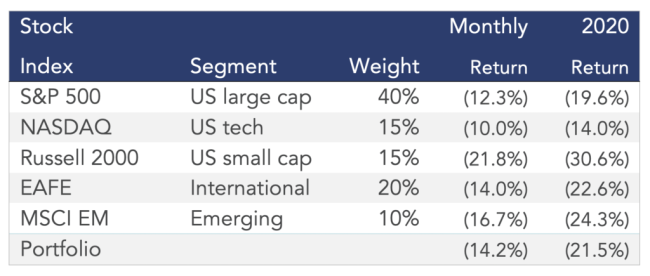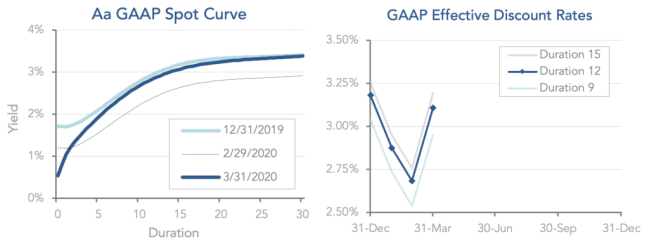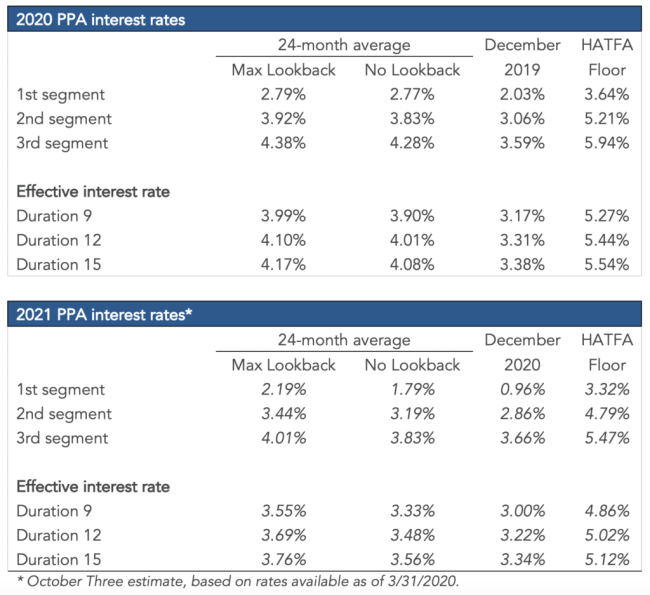
March 2020 Pension Finance Update
Tumbling stock markets dealt another blow to pension sponsors in March. Both model plans we track[1] lost ground: Plan A lost 3% in March, ending the quarter 13% lower than at the end of 2019, while Plan B slipped more than 1% and is now down more than 4% for the year:

Assets
Falling stock markets intensified in March. All major indexes suffered double-digit losses for the month, and a diversified basket of stocks is now down more than 20% in the first quarter of 2020.

Treasury rates fell yet another 0.3% in March, ending the quarter a full percent below the end of 2019. Corporate yields, in contrast, jumped 0.4% as credit spreads widened dramatically last month.
As a result, Treasuries gained 4% in March, while corporate bonds lost 5%. In both cases, movements among long duration bonds was the most significant. Overall, bonds were flat to down 3% last month and are now up 3%-6% for the year, with Treasury portfolios significantly outperforming.
Overall, our traditional 60/40 portfolio lost more than 8% in March and is now down more than 11% for the year, while the conservative 20/80 lost 6% last month and is now down 3% through the first quarter of 2020.
Liabilities
Pension liabilities (for funding, accounting, and de-risking purposes) are driven by market interest rates. The first graph below compares our Aa GAAP spot yield curve at December 31, 2019 and March 31, 2020 and it also shows the movement in the curve last month. The second graph below shows our estimate of movements in effective GAAP discount rates for pension obligations of various duration during 2020:

Corporate bond yields jumped 0.4% in March, close to where they ended 2019. As a result, pension liabilities fell 4%-7% during the month. Liabilities are now about 2% higher than at the end of 2019 for plans of all durations.
Summary
Stock markets have slid dramatically this year, with volatility and uncertainty at record highs. The fall in March was cushioned in part by widening credit spreads, which pushed corporate bond yields up and pension liabilities down. The graphs below show the movement of assets and liabilities during the first quarter of 2020:

Looking Ahead
Pension funding relief has reduced required plan funding since 2012, but under current law, this relief will gradually sunset. Given the current level of market interest rates, it is possible that relief reduces the funding burden through 2028, but the rates used to measure liabilities will move significantly lower over the next few years, increasing funding requirements for pension sponsors that have only made required contributions.
2020 experience, if it persists, will not increase required contributions until 2022, compounding higher funding requirements due to the fading of funding relief. There is a reasonable chance we get more relief this year, but at this point it’s too soon to say for certain.
Discount rates moved higher last month. We expect most pension sponsors will use effective discount rates in the 2.9%-3.3% range to measure pension liabilities right now.
The table below summarizes rates that plan sponsors are required to use for IRS funding purposes for 2020, along with estimates for 2021. Pre-relief, both 24-month averages and December ‘spot’ rates, which are still required for some calculations, such as PBGC premiums, are also included.

[1] Plan A is a traditional plan (duration 12 at 5.5%) with a 60/40 asset allocation, while Plan B is a largely retired plan (duration 9 at 5.5%) with a 20/80 allocation with a greater emphasis on corporate and long-duration bonds. We assume overhead expenses of 1% of plan assets per year, and we assume the plans are 100% funded at the beginning of the year and ignore benefit accruals, contributions, and benefit payments in order to isolate the financial performance of plan assets versus liabilities.
